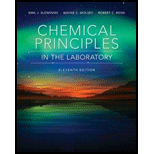
Concept explainers
As pure elements, all of the halogens are diatomic molecular species. Their melting points are:
Elemental formula: ______ Phase at room temperature: ______
Interpretation:
The elemental formula and phase of elemental astatine are to be stated.
Concept introduction:
The periodic table is an important part of chemistry. In this table, all known elements are arranged on the basis of their atomic number. Elements having same outer electronic configuration are kept in same groups. The elements on left of periodic table are metals, on right are nonmetals and in center are transition metals and metalloids.
Answer to Problem 1ASA
The elemental formula of astatine is
Explanation of Solution
The elemental forms of other members of astatine group are
The melting points of
Since astatine is present after iodine in the group, therefore, its melting point is higher than
So,
The elemental formula of astatine is
Want to see more full solutions like this?
Chapter 12 Solutions
Chemical Principles in the Laboratory
- Which of the following are isotopes of element X, the atomic number for which is 9: 919X, 920X, 189X, and 921X?arrow_forwardHundreds of years ago, alchemists tried to turn lead into gold. Is this possible? If not, why not? If yes, how would you do it?arrow_forwardMass spectrometric analysis showed that there are four isotopes of an unknown element having the following masses and abundances: Three elements in the periodic table that have atomic weights near these values are lanthanum (La), atomic number 57, atomic weight 138.9055; cerium (Ce), atomic number 58, atomic weight 140.115; and praseodymium (Pr), atomic number 59, atomic weight 140.9076. Using the data above, calculate the atomic weight, and identify the element if possible.arrow_forward
 Chemistry & Chemical ReactivityChemistryISBN:9781337399074Author:John C. Kotz, Paul M. Treichel, John Townsend, David TreichelPublisher:Cengage Learning
Chemistry & Chemical ReactivityChemistryISBN:9781337399074Author:John C. Kotz, Paul M. Treichel, John Townsend, David TreichelPublisher:Cengage Learning Chemistry & Chemical ReactivityChemistryISBN:9781133949640Author:John C. Kotz, Paul M. Treichel, John Townsend, David TreichelPublisher:Cengage Learning
Chemistry & Chemical ReactivityChemistryISBN:9781133949640Author:John C. Kotz, Paul M. Treichel, John Townsend, David TreichelPublisher:Cengage Learning Chemistry: The Molecular ScienceChemistryISBN:9781285199047Author:John W. Moore, Conrad L. StanitskiPublisher:Cengage Learning
Chemistry: The Molecular ScienceChemistryISBN:9781285199047Author:John W. Moore, Conrad L. StanitskiPublisher:Cengage Learning Introductory Chemistry: An Active Learning Approa...ChemistryISBN:9781305079250Author:Mark S. Cracolice, Ed PetersPublisher:Cengage Learning
Introductory Chemistry: An Active Learning Approa...ChemistryISBN:9781305079250Author:Mark S. Cracolice, Ed PetersPublisher:Cengage Learning Chemistry: Principles and ReactionsChemistryISBN:9781305079373Author:William L. Masterton, Cecile N. HurleyPublisher:Cengage Learning
Chemistry: Principles and ReactionsChemistryISBN:9781305079373Author:William L. Masterton, Cecile N. HurleyPublisher:Cengage Learning Introductory Chemistry: A FoundationChemistryISBN:9781337399425Author:Steven S. Zumdahl, Donald J. DeCostePublisher:Cengage Learning
Introductory Chemistry: A FoundationChemistryISBN:9781337399425Author:Steven S. Zumdahl, Donald J. DeCostePublisher:Cengage Learning





